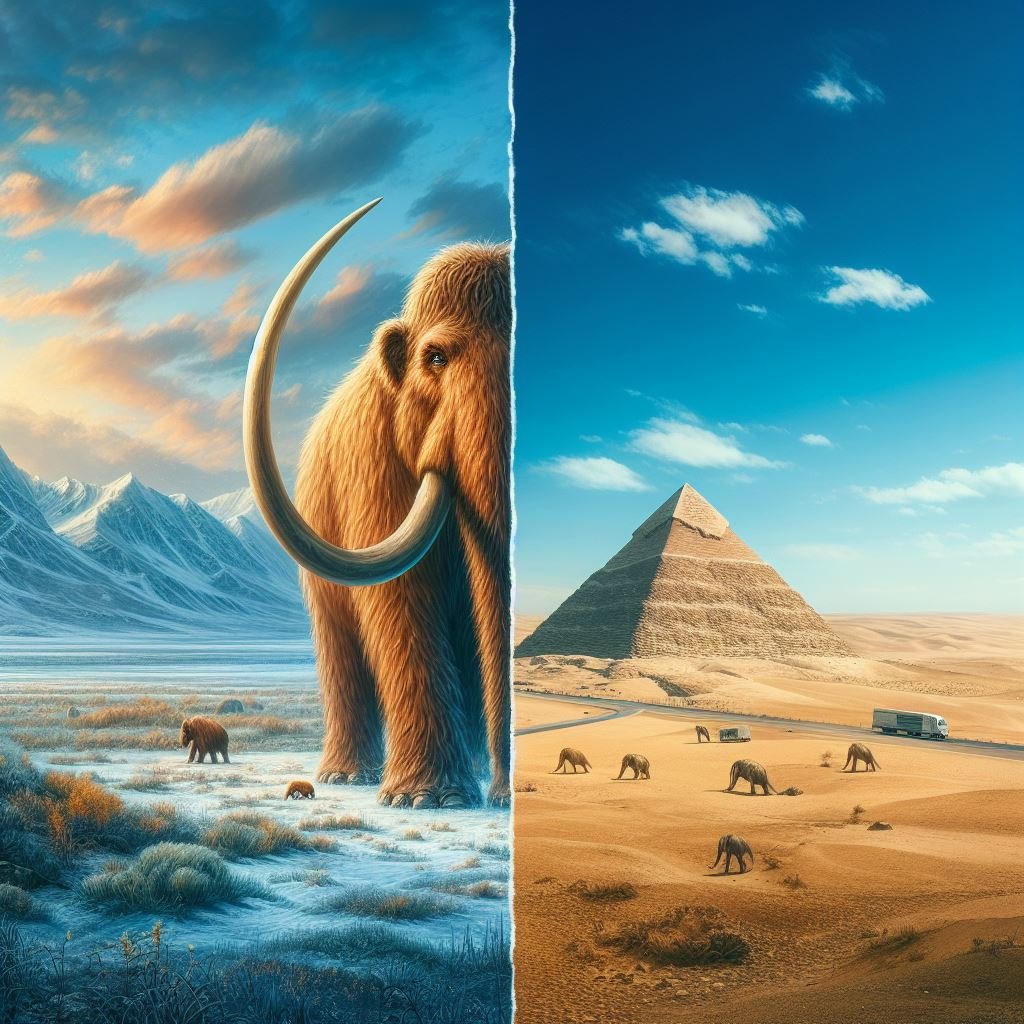The pyramids of Giza stand as enduring testaments to human civilization, their colossal forms reaching skyward for millennia. Yet, the story of these ancient structures extends beyond the ingenuity of the pharaohs. Believe it or not, as these pyramids were being built, another story was unfolding on a different continent – the story of the wooly mammoth.
These majestic creatures, with their thick fur and impressive tusks, were once a dominant presence across the northern hemisphere. While their image often evokes thoughts of the distant Ice Age, their extinction wasn’t as remote as you might think. Recent research suggests that the last wooly mammoths clung to existence on Wrangel Island in the Arctic Ocean until a surprisingly recent date – around 1650 BC.
That date is significant. It places the final chapter of the wooly mammoth’s story a mere 900 years after the completion of the Great Pyramid of Giza, estimated to be built around 2560 BC. Imagine the world as these two vastly different narratives coexisted. While skilled artisans in Egypt were carving stone and constructing monuments that would defy time, on the other side of the globe, wooly mammoths were roaming a frigid landscape, unaware of the civilization flourishing thousands of miles away.
A Mammoth Mystery: Unveiling the Last Stand
The story of the wooly mammoth’s decline and eventual extinction is a complex one, shrouded in some degree of mystery. Here’s what we know:
- Climate Change: The gradual warming of the Earth at the end of the last Ice Age undeniably played a role. As temperatures rose and glaciers retreated, the mammoth’s preferred habitat – vast grasslands and cold steppes – began to shrink.
- Habitat Loss: This changing environment forced mammoths to adapt or migrate. While some populations ventured further north, others likely faced dwindling resources and competition for food from emerging herbivores better suited to the warmer climate.
- Hunting: The presence of humans in some regions where mammoths lived raises the question of human predation. While the extent of human impact is still debated, it’s possible that early humans contributed to the decline of some mammoth populations through hunting.
Wrangel Island: A Last Refuge
Wrangel Island, a remote landmass north of Siberia, provided a unique sanctuary for a small population of wooly mammoths. Isolated by rising sea levels around 10,000 years ago, the island preserved a cold, tundra-like environment similar to their ancestral home.
These isolated mammoths exhibited some physical differences from their mainland counterparts, possibly due to limited genetic diversity in the smaller population. However, they continued to thrive on Wrangel Island for several millennia, a testament to their resilience.
The Final Chapter: Why Did They Disappear Here Too?
Despite the island haven, the wooly mammoth’s story came to an end on Wrangel Island as well. The exact cause of their extinction here is still under investigation. Some theories suggest:
- Limited Resources: Even on Wrangel Island, food sources might have become depleted over time, especially considering the limited landmass. This could have led to starvation or malnutrition.
- Disease: A contagious illness spreading through the small, isolated population could have been a devastating factor.
- Human Activity: While evidence is scarce, some scientists believe humans may have reached Wrangel Island much later, potentially impacting the mammoth population through hunting or disease introduction.
A Window into the Past: Echoes of Giants
The co-existence of these two stories – the enduring pyramids and the vanishing wooly mammoths – offers a fascinating glimpse into the vastness of time. It highlights the adaptability and vulnerability of life on Earth, and the profound changes our planet has undergone.
The study of wooly mammoths continues to yield valuable information about past climates, ecosystems, and human interaction with the environment. Their fossilized remains and preserved DNA hold clues to their biology, migration patterns, and ultimately, the reasons behind their extinction. Understanding this story allows us to better appreciate the delicate balance of our own environment and the potential impact of climate change on present-day species.
Beyond the Pyramids: A Legacy of Giants
The wooly mammoth’s story is not just one of extinction; it’s a reminder of the remarkable creatures that once roamed the Earth. Their immense size, impressive tusks, and adaptation to harsh environments continue to capture our imagination.
They represent a bygone era, a time when mammoths were part of the natural world alongside our early human ancestors. Their legacy lives on through fossils, scientific research, and the stories we tell about these fascinating creatures.
The next time you gaze upon a picture of the pyramids, remember the echoes of giants that may have still been roaming distant



